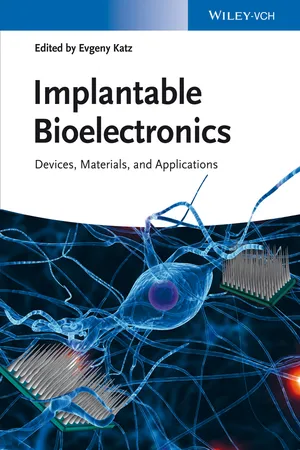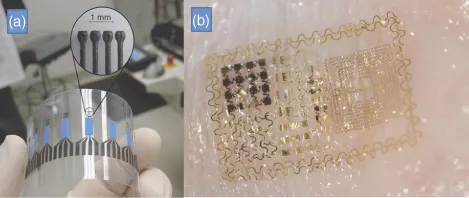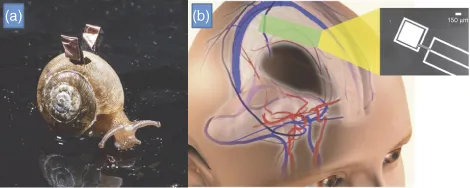
- English
- ePUB (mobile friendly)
- Available on iOS & Android
eBook - ePub
Implantable Bioelectronics
About this book
Here the renowned editor Evgeny Katz has chosen contributions that cover a wide range of examples and issues in implantable bioelectronics, resulting in an excellent overview of the topic. The various implants covered include biosensoric and prosthetic devices, as well as neural and brain implants, while ethical issues, suitable materials, biocompatibility, and energy-harvesting devices are also discussed.
A must-have for both newcomers and established researchers in this interdisciplinary field that connects scientists from chemistry, material science, biology, medicine, and electrical engineering.
A must-have for both newcomers and established researchers in this interdisciplinary field that connects scientists from chemistry, material science, biology, medicine, and electrical engineering.
Frequently asked questions
Yes, you can cancel anytime from the Subscription tab in your account settings on the Perlego website. Your subscription will stay active until the end of your current billing period. Learn how to cancel your subscription.
At the moment all of our mobile-responsive ePub books are available to download via the app. Most of our PDFs are also available to download and we're working on making the final remaining ones downloadable now. Learn more here.
Perlego offers two plans: Essential and Complete
- Essential is ideal for learners and professionals who enjoy exploring a wide range of subjects. Access the Essential Library with 800,000+ trusted titles and best-sellers across business, personal growth, and the humanities. Includes unlimited reading time and Standard Read Aloud voice.
- Complete: Perfect for advanced learners and researchers needing full, unrestricted access. Unlock 1.4M+ books across hundreds of subjects, including academic and specialized titles. The Complete Plan also includes advanced features like Premium Read Aloud and Research Assistant.
We are an online textbook subscription service, where you can get access to an entire online library for less than the price of a single book per month. With over 1 million books across 1000+ topics, we’ve got you covered! Learn more here.
Look out for the read-aloud symbol on your next book to see if you can listen to it. The read-aloud tool reads text aloud for you, highlighting the text as it is being read. You can pause it, speed it up and slow it down. Learn more here.
Yes! You can use the Perlego app on both iOS or Android devices to read anytime, anywhere — even offline. Perfect for commutes or when you’re on the go.
Please note we cannot support devices running on iOS 13 and Android 7 or earlier. Learn more about using the app.
Please note we cannot support devices running on iOS 13 and Android 7 or earlier. Learn more about using the app.
Yes, you can access Implantable Bioelectronics by Evgeny Katz in PDF and/or ePUB format, as well as other popular books in Biological Sciences & Biochemistry. We have over one million books available in our catalogue for you to explore.
Information
Chapter 1
Implantable Bioelectronics – Editorial Introduction
The integration of electronic elements with biological systems, resulting in novel devices with unusual functionalities, attracts significant research efforts owing to fundamental scientific interest and the possible practical applications of such devices. The commonly used buzzword “bioelectronics” highlights the functional integration of two different areas of science and engineering – biology and electronics, to yield a novel subarea of biotechnology [1, 2]. Bioelectronics is a rapidly developing, multidisciplinary research direction, combining novel achievements from electronics miniaturization allowing devices to operate with ultralow power consumption [3], the development of flexible devices for interfacing with biological tissue via advances within materials science [4], bio-inspired unconventional computing for mimicking biological information processing [5], and many other highly innovative science and technology areas. One of the most advanced applications benefiting from the development of bioelectronics is the rapidly progressing area of biosensors technology [6]. The use of novel nanostructured materials integrated with biomolecular systems [7–9] tremendously contributes to the rapid progress of bioelectronics, especially in regard to biosensor applications [10]. The novel electronic systems based on flexible supports [11] for direct interfacing with biological tissues are very promising for use in implantable bioelectronic devices [12] (Figure 1.1).

Figure 1.1 (a) Flexible bioelectronic devices allow interfacing with a biological tissue. (b) A new type of biosensor uses flat, flexible electronics (“tattoo”-bioelectronics) printed on a thin rubbery sheet, which can stick to human skin for at least 24 h.
(Photos “a” and “b” were kindly provided by Prof. Joseph Wang, University California San Diego, USA, and Prof. John A. Rogers, University of Illinois at Urbana-Champaign, USA, respectively.)
The most challenging developments in bioelectronics are related to biomedical applications, particularly advancing the direct coupling of electronic devices/machines with living organisms, where electronics operates in a biological environment implanted within a living body. This technology is already highly advanced, at least in some medical applications such as implantable cardiostimulators [13, 14] and various other implantable prosthetic devices [15, 16]. The most important issue in the biotechnological engineering of implantable devices is the interface between living tissues and artificial man-made implantable devices. Cardiac defibrillators/pacemakers, deep brain neurostimulators, spinal cord stimulators, gastric stimulators, foot drop implants, cochlear implants, insulin pumps, retinal implants, implantable neural electrodes, muscle implants, and other implantable devices must perform their functions by directly interacting with the respective organs to improve their natural operation or substitute the missing function. Implantable medical devices can also restore function by integrating with nondamaged tissue within an organ. The artificially generated electrical and sometimes electromechanical activity in each of these cases must be engineered within the context of the physiological system and its biological characteristics. For example, in one of the recent research projects [17], a nervous system was wired to a robotic hand, allowing its remote control (Figure 1.2). Neural signals were transmitted to various technological devices to directly control them, in some cases via the Internet, and feedback to the brain was obtained from, for example, the fingertips of the robot hand [17].

Figure 1.2 Prof. Warwick had his nervous system wired to a robotic hand allowing its remote control. (a) A 100-electrode array surgically implanted into the median nerve fibers of the left arm allowed electrical reading of nerve signals. (b) The robotic hand was remotely controlled by signals from the researcher's nervous system.
(Photos “a” and “b” were kindly provided by Prof. Kevin Warwick, University of Reading, UK.)
Highly integrated systems also make possible the development of implantable devices that can sense their biological environment in real time and properly respond to the changing conditions. Integrated “Sense-and-Act” systems for intelligent drug delivery have emerged, contributing to the novel concept of personalized medicine and appear particularly important for advancing point-of-care and end-user applications [18]. Although very sophisticated digital electronics can provide perfect internal operation of the implantable devices, their interfacing with the biological environment requires further advancement. New materials and novel concepts are needed for improved interfacing of the biological and electronic systems. Improving biocompatibility, via surface chemistry, is critical for enabling future implantable bioelectronic devices. Information processing by the integrated biological/electronic system requires novel computational approaches because natural information processing is conceptually different from the digital operation used in modern electronics. New methods for harvesting and managing energy to power implantable devices are required [19, 20]. They can be based on bio-inspired approaches using, for example, implantable biofuel cells harvesting energy from the internal physiological resources [21–23] (Figure 1.3). Revolutions in miniaturized electronic devices, cognitive science, bioelectronics, bio-inspired unconventional computing, nanotechnology, and applied neural control technologies are resulting in breakthroughs in the integration of humans and machines. The interactions of electronic computing elements, wireless information processing systems, advances in prosthetic devices, and artificial implants facilitate the merging of humans with machines. These exciting advancements lay the foundation for the development of bionic animal/human–machine hybrids [24] (Figures 1.4 and 1.5). Apart from biomedical applications, one can foresee bioelectronic self-powered “cyborgs” capable of autonomous operation using power from biological sources, utilized in environmental monitoring, homeland security, and military applications.

Figure 1.3 Implantation of biofuel cells in a living tissue can provide electrical power harvested from metabolic species for activating implantable bioelectronic devices. (a) A biofuel cell implanted in a free moving snail. ...
Table of contents
- Cover
- Related Titles
- Title Page
- Copyright
- Preface
- List of Contributors
- Chapter 1: Implantable Bioelectronics – Editorial Introduction
- Chapter 2: Magnetically Functionalized Cells: Fabrication, Characterization, and Biomedical Applications
- Chapter 3: Untethered Insect Interfaces
- Chapter 4: Miniaturized Biomedical Implantable Devices
- Chapter 5: Cross-Hierarchy Design Exploration for Implantable Electronics
- Chapter 6: Neural Interfaces: from Human Nerves to Electronics
- Chapter 7: Cyborgs – the Neuro-Tech Version
- Chapter 8: Interaction with Implanted Devices through Implanted User Interfaces
- Chapter 9: Ultralow Power and Robust On-Chip Digital Signal Processing for Closed-Loop Neuro-Prosthesis
- Chapter 10: Implantable CMOS Imaging Devices
- Chapter 11: Implanted Wireless Biotelemetry
- Chapter 12: Nano-Enabled Implantable Device for Glucose Monitoring
- Chapter 13: Improving the Biocompatibility of Implantable Bioelectronics Devices
- Chapter 14: Abiotic (Nonenzymatic) Implantable Biofuel Cells
- Chapter 15: Direct-Electron-Transfer-Based Enzymatic Fuel Cells In Vitro,Ex Vivo, and In Vivo
- Chapter 16: Enzymatic Fuel Cells: From Design to Implantation in Mammals
- Chapter 17: Implanted Biofuel Cells Operating In Vivo
- Chapter 18: Biomedical Implantable Systems – History, Design, and Trends
- Chapter 19: Brain–Computer Interfaces: Ethical and Policy Considerations
- Chapter 20: Conclusions and Perspectives
- Index